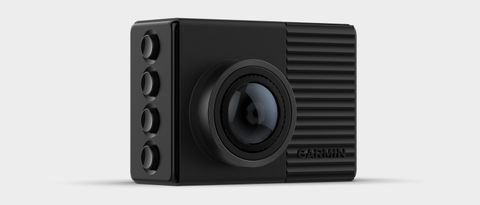Garmin has been producing some of the best dash cams for a while, and with its pedigree for manufacturing other automotive devices this is no surprise. The Dash Cam 66W shoots 2.5K video, which appears to be the current typical resolution, and has a form factor not unlike a GoPro action camera. The W in the name singles it out as the Garmin model that offers a particularly wide angle of view.
There’s a built-in GPS and the 66W also integrates some advanced safety features. You can even operate some of the functions with your voice. However, this is quite a pricey option at well over $200, which looks a little like you are paying for the Garmin name. However, the more you explore the 66W abilities, the more you realize that it packs a lot into its tiny package.
Garmin Dash Cam 66W: Features
- 2.5K video shooting GPS for location tracking
- G sensor for collision detection
- Travelapse grabs a fast-motion summary of your trip
Resolution: 2.5K 2,560 x 1,440 maximum resolution
Screen: 2-inch touch LCD display
GPS: Built-in
Additional Safety Features: G-sensor for detecting incidents; forward collision and lane departure warnings; safety camera locations.
Wireless: Yes
The top video recording resolution is 2.5K, which equates to 2,560 x 1,440, at 30 frames per second, with HDR enabled. You can also capture 1080p Full HD at 60 frames per second or 30 frames per second with HDR, and 720p at 30 frames per second with HDR. At the top 2.5K resolution, video is recorded at healthy 29Mbits/sec, so a 16GB Micro SD card will be enough for 75 minutes of footage before looping begins. The high data rate bodes well for image quality.
The lens has a wide 180-degree field of view, which is the main difference between this and the Garmin Dash Cam 56. It is a bit of a surprise that you pay a good $50 more for this benefit, although it is really useful to be able to see such a wide angle from just one lens.
The Garmin Dash Cam 66W (and 56) have a good array of bonus features, too. There’s a Travelapse option, which grabs a fast-motion summary of your trip alongside the regular dash cam footage, and doesn’t overwrite earlier files. You can use this to capture a record of a driving trip to show friends.
GPS is built in, so that your location is recorded alongside the video. This supports the EU’s Galileo satellites as well as American GPS network. The GPS is also harnessed to warn you of safety cameras and red-light locations, although this merely makes a chime noise rather than telling you what the speed limit is and whether you’re exceeding it.
The 66W integrates some other advanced safety features as well, including forward collision warnings with low, medium or high sensitivity options and lane departure warnings. You can also be alerted when the traffic in front starts moving in a jam. Overall, it’s a comprehensive package.
Garmin Dash Cam 66W: Design and build
- Magnetic mount
- 2-in LCD display
- Voice control
The Garmin Dash Cam 66W is one of the smallest dash cams we’ve tested. Most of the rear is dominated by the 2-inch LCD display, which isn’t a touch screen. Instead, there are four icons down the right-hand side of the screen that let you know what the functions of the four buttons on the right-hand end of the device do. These operate the various menus, which are mostly text-based.
The mounting system used by the 66W is rather understated. The windscreen connection is exclusively adhesive, which at first makes you think you won’t be able to remove the unit easily after installation. But in fact, the bit that sticks to the windscreen is a small magnetic disc, which the plastic arm then connects to. So it’s actually quite easy to remove the 66W. However, the car power adapter isn’t integrated into the mount, so you have to connect this to the device as well, making removal and reattachment not quite as slick as the Vantrue N2 Pro or Nextbase 422GW.
On the plus side, the car power adapter involves a USB cable and separate cigarette lighter module, with the latter including two regular USB ports. This means that if your sat-nav has a USB cable as well, you can run this at the same time. Or you can plug your phone’s power cable in, if you use that as your navigational system. This is a nice touch, and it’s a surprise more manufacturers don’t take this approach when most people do tend to run both dash cams and navigation devices at once.
Although Garmin doesn’t publicize this much on the specifications found on its website, the 66W does have integrated Bluetooth and WiFi. This works in tandem with the Drive app. You use the device and the app to pair your phone over Bluetooth and can then control settings. If you want to see a live preview from the camera or download files, the app will automatically enable WiFi on the 66W and then attach your smartphone to it for a higher-bandwidth connection.
Garmin has also added limited voice control to the 66W. This is nowhere near as extensive as the Alexa facility found in Nextbase’s latest premium models, but this makes it easier to use. You simply announce “OK Garmin” and a list of options appears onscreen, from which you can choose. This is particularly useful for saving the current recording, so it doesn’t get overwritten in the looping process, or starting and stopping the Travelapse recording.
Garmin Dash Cam 66W: Performance
- Mediocre 2.5K image quality
- Low-resolution
- GLV file recorded for backup
Garmin stipulates that a class 10 microSDHC card is required for the 66W, and it isn’t kidding. When we tried to use media that wasn’t rated at this level, we were informed by the device itself that class 10 media was needed, and no video was recorded after that. Once we had installed media with a sufficient rating, recording began as expected.
The 66W captures a main file at 29Mbits per second, plus backup GLV file at a much lower data rate. However, despite the higher data rate for the main file than some dash cams we’ve reviewed, the 66W does not perform as well as many other devices offering 2.5K resolution. The footage is surprisingly affected by grain, which rendered text hard to discern. This rather reduces the value of this dash cam for its core duty of providing evidence in the case of an incident.
Garmin Dash Cam 66W: Verdict
The Garmin Dash Cam 66W has some great safety features rolled into a tiny, discrete form. The built-in GPS provides location tracking and safety camera notifications, plus you get collision detection and lane departure. The Travelapse feature provides recreational value along with the surveillance function, and there’s functional voice control too. Image quality could be a bit better and not quite what we'd expect for a premium dash cam.


